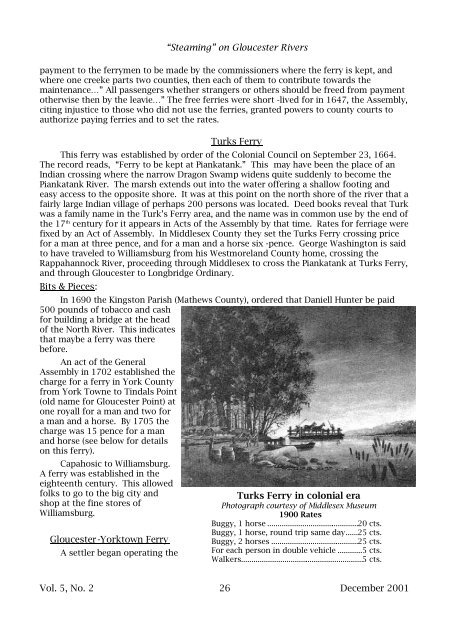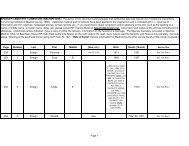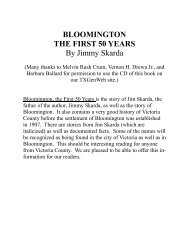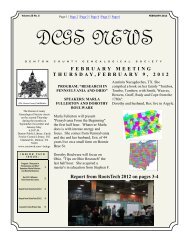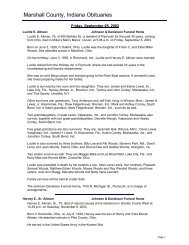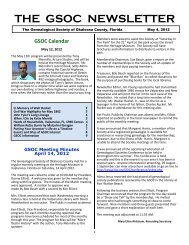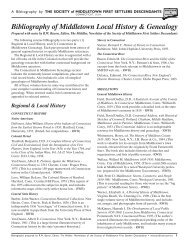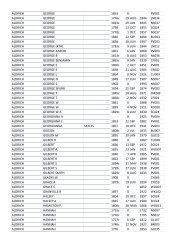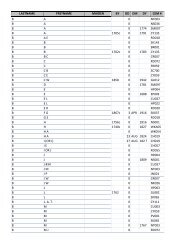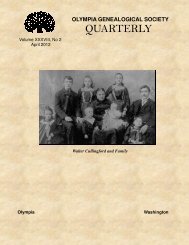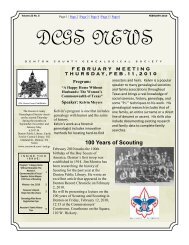The Family Tree Searcher - RootsWeb
The Family Tree Searcher - RootsWeb
The Family Tree Searcher - RootsWeb
Create successful ePaper yourself
Turn your PDF publications into a flip-book with our unique Google optimized e-Paper software.
“Steaming” on Gloucester Rivers<br />
payment to the ferrymen to be made by the commissioners where the ferry is kept, and<br />
where one creeke parts two counties, then each of them to contribute towards the<br />
maintenance…” All passengers whether strangers or others should be freed from payment<br />
otherwise then by the leavie…” <strong>The</strong> free ferries were short -lived for in 1647, the Assembly,<br />
citing injustice to those who did not use the ferries, granted powers to county courts to<br />
authorize paying ferries and to set the rates.<br />
Turks Ferry<br />
This ferry was established by order of the Colonial Council on September 23, 1664.<br />
<strong>The</strong> record reads, “Ferry to be kept at Piankatank.” This may have been the place of an<br />
Indian crossing where the narrow Dragon Swamp widens quite suddenly to become the<br />
Piankatank River. <strong>The</strong> marsh extends out into the water offering a shallow footing and<br />
easy access to the opposite shore. It was at this point on the north shore of the river that a<br />
fairly large Indian village of perhaps 200 persons was located. Deed books reveal that Turk<br />
was a family name in the Turk’s Ferry area, and the name was in common use by the end of<br />
the 17 th century for it appears in Acts of the Assembly by that time. Rates for ferriage were<br />
fixed by an Act of Assembly. In Middlesex County they set the Turks Ferry crossing price<br />
for a man at three pence, and for a man and a horse six -pence. George Washington is said<br />
to have traveled to Williamsburg from his Westmoreland County home, crossing the<br />
Rappahannock River, proceeding through Middlesex to cross the Piankatank at Turks Ferry,<br />
and through Gloucester to Longbridge Ordinary.<br />
Bits & Pieces:<br />
In 1690 the Kingston Parish (Mathews County), ordered that Daniell Hunter be paid<br />
500 pounds of tobacco and cash<br />
for building a bridge at the head<br />
of the North River. This indicates<br />
that maybe a ferry was there<br />
before.<br />
An act of the General<br />
Assembly in 1702 established the<br />
charge for a ferry in York County<br />
from York Towne to Tindals Point<br />
(old name for Gloucester Point) at<br />
one royall for a man and two for<br />
a man and a horse. By 1705 the<br />
charge was 15 pence for a man<br />
and horse (see below for details<br />
on this ferry).<br />
Capahosic to Williamsburg.<br />
A ferry was established in the<br />
eighteenth century. This allowed<br />
folks to go to the big city and<br />
shop at the fine stores of<br />
Williamsburg.<br />
Gloucester-Yorktown Ferry<br />
A settler began operating the<br />
Turks Ferry in colonial era<br />
Photograph courtesy of Middlesex Museum<br />
1900 Rates<br />
Buggy, 1 horse ............................................20 cts.<br />
Buggy, 1 horse, round trip same day......25 cts.<br />
Buggy, 2 horses ..........................................25 cts.<br />
For each person in double vehicle ............5 cts.<br />
Walkers...........................................................5 cts.<br />
Vol. 5, No. 2 26 December 2001


